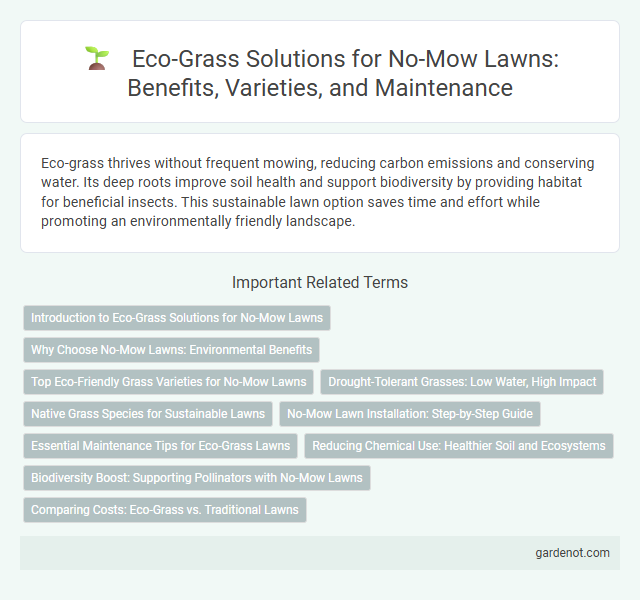Eco-grass thrives without frequent mowing, reducing carbon emissions and conserving water. Its deep roots improve soil health and support biodiversity by providing habitat for beneficial insects. This sustainable lawn option saves time and effort while promoting an environmentally friendly landscape.
Introduction to Eco-Grass Solutions for No-Mow Lawns
Eco-grass solutions for no-mow lawns utilize drought-resistant and low-maintenance grass varieties that thrive without regular mowing. These grasses reduce water consumption and limit the need for fertilizers, promoting sustainable lawn care. Implementing eco-grass supports biodiversity and enhances soil health while minimizing environmental impact.
Why Choose No-Mow Lawns: Environmental Benefits
No-mow lawns with Eco-grass significantly reduce water consumption and lower carbon emissions by eliminating the need for frequent mowing and irrigation. These sustainable landscapes enhance soil health by promoting natural aeration and supporting beneficial microorganisms, which contribute to a healthier ecosystem. Choosing Eco-grass no-mow lawns helps conserve biodiversity while reducing reliance on chemical fertilizers and pesticides, fostering an environmentally friendly approach to lawn care.
Top Eco-Friendly Grass Varieties for No-Mow Lawns
Top eco-friendly grass varieties for no-mow lawns include fine fescues like creeping red fescue and chewings fescue, prized for their low growth habit and drought tolerance. Buffalo grass offers a native, heat-resistant option requiring minimal water and mowing, ideal for sustainable landscaping. These grasses reduce maintenance, conserve resources, and support biodiversity, making them optimal choices for environmentally conscious no-mow lawn designs.
Drought-Tolerant Grasses: Low Water, High Impact
Eco-grass varieties such as buffalo grass and Bermuda grass thrive with minimal water, making them ideal for drought-prone regions. These drought-tolerant grasses maintain vibrant color and density while significantly reducing irrigation needs, conserving water resources. Their deep root systems enhance soil health and resilience, ensuring a lush, low-maintenance lawn with high environmental impact.
Native Grass Species for Sustainable Lawns
Eco-grass made from native grass species enhances sustainable lawns by promoting biodiversity and requiring minimal water and fertilizer. These grasses naturally adapt to local soil and climate conditions, reducing maintenance and environmental impact. Utilizing native species supports healthier ecosystems and creates resilient, no-mow lawn alternatives.
No-Mow Lawn Installation: Step-by-Step Guide
Eco-grass No-Mow Lawn Installation begins with thorough site preparation, including soil aeration and leveling to ensure optimal root development. Next, lay the Eco-grass rolls seamlessly, securing edges with landscape staples or adhesive to prevent shifting. Final steps involve minimal watering to promote root establishment, resulting in a durable, maintenance-free lawn that conserves water and eliminates mowing.
Essential Maintenance Tips for Eco-Grass Lawns
Eco-grass lawns require minimal mowing, saving time and reducing emissions, but essential maintenance includes regular watering to establish roots and occasional aeration to prevent soil compaction. Applying a balanced, slow-release fertilizer in early spring supports healthy growth while controlling weeds with organic herbicides promotes a chemical-free environment. Monitoring soil pH and adjusting with lime or sulfur as needed ensures optimal nutrient uptake for a dense, resilient eco-grass lawn.
Reducing Chemical Use: Healthier Soil and Ecosystems
Eco-grass varieties significantly reduce the need for chemical fertilizers and pesticides, promoting healthier soil ecosystems. These low-maintenance grasses enhance microbial activity and increase biodiversity, leading to improved soil structure and nutrient cycling. By minimizing chemical inputs, eco-grass supports sustainable lawn care practices that protect surrounding wildlife and water quality.
Biodiversity Boost: Supporting Pollinators with No-Mow Lawns
Eco-grass in no-mow lawns fosters biodiversity by creating habitats that support pollinators like bees and butterflies, essential for ecosystem health. Reduced mowing preserves wildflowers and native plants, increasing food sources and nesting sites for these crucial insects. This sustainable lawn practice enhances pollinator populations, promoting thriving, balanced urban and suburban ecosystems.
Comparing Costs: Eco-Grass vs. Traditional Lawns
Eco-grass significantly reduces long-term maintenance expenses compared to traditional lawns by eliminating the need for mowing, watering, and fertilizing. Initial installation costs for eco-grass may be comparable or slightly higher, but savings on equipment, water bills, and lawn care services quickly offset this investment. Over time, eco-grass provides a cost-effective, sustainable alternative that supports environmental conservation and lowers household upkeep costs.
Eco-grass Infographic

 gardenot.com
gardenot.com